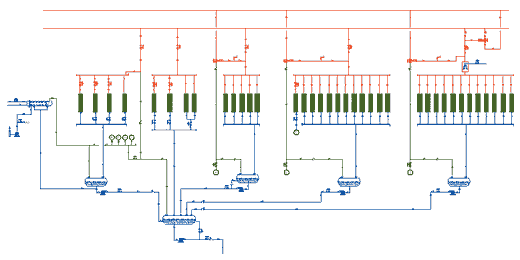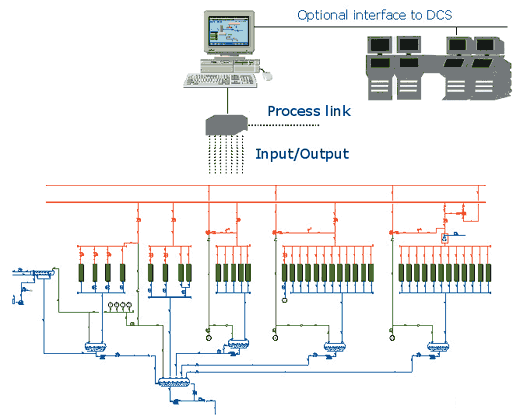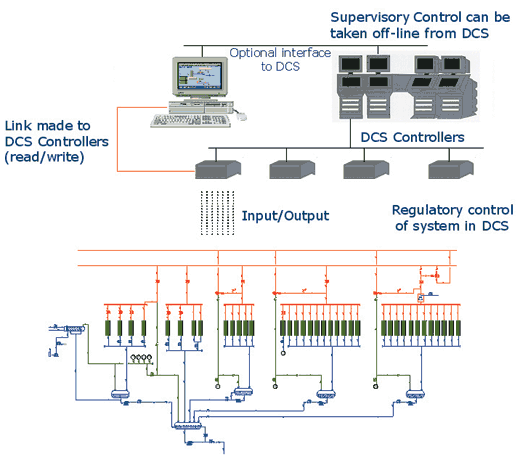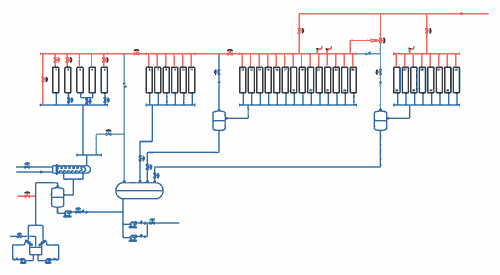Improving dryer control
by Kenneth C Hill, David Vijh and Rene Boudreau
Monitoring dryers may have created production problems in the past, but with supervisory control now making itself known, dryer headaches could be banished forever
Significant improvements in dryer section operation and energy efficiency have been achieved through the close integration of supervisory control and steam system design. Supervisory control of all system set points is used to optimize system operation and provide ease of use for the operators. Steam pressures, flows and differentials are managed under machine operating conditions including sheet breaks, tail threading, grade changes and startups.
The control system is designed to achieve all of this without the need for operator intervention. System designs can be simplified and a very wide operating pressure range is produced. Supervisory control assures that the dryer operation is consistent for different machine operating conditions and machine crews. This improved consistency results in better dryer section runnability by producing the same dryness curve as the sheet progresses through the dryer section.
Different drying strategies can be used in the wet end "quality zone" to provide consistent sheet quality and runnability. Dryer pressures are varied according to a predefined set of pressure curves that ensures proper wet end sheet temperature graduation.
A wider range of operation can be achieved with supervisory control. Upper and lower operating limits are difficult to maintain without continuous adjustment. Operators are unable to make these fine adjustments to a traditionally controlled system.
The energy efficiency of the system is optimized. Establishing the proper relationships and operating limits minimize venting and steam waste. Steam is conserved during upset and sheet off conditions.
Using the system becomes much easier. There is little need for operator adjustment. All system functions are driven from the moisture gage and the sheet break detectors. When adjustment is necessary, it is done using "Increase Drying/ Decrease Drying" controls.
Traditional dryer drainage
Figure 1 shows a typical dryer drainage system for a lightweight coated (LWC) machine. This system is considered to be well-designed by traditional standards. It incorporates thermocompressors for flexibility, blow-through flow control, individual control of wet end dryers and flash steam recovery using a common collection tank. Within this system there are 35 control valves, 32 transmitters, 12 pressure loops, three flow loops, 10 differential pressure loops, two temperature loops and five level loops.
Figure 1: Typical LWC dryer drainage system
 |
|
Even though most dryer drainage systems are controlled through a distributed control system (DCS), the control is typically single loop. The moisture gauge would drive the pressure of the final steam group to control reel moisture. Generally, it is up to the operator to establish the system set points for the remaining sections. Occasionally, there are simple relationships programmed into the DCS to adjust pressures in some of the other sections based on the pressure of the moisture control group. The operator has to adjust all differential pressure and blow-through flow settings, and monitor all other loops to ensure the operation and set point is correct.
The operator should adjust all system pressures as machine conditions change, understand the operating limits of the system, understand how the pressure changes affect the interactions within the system, adjust differential pressures as machine conditions change, manage pressures on grade changes, reset dryer pressures following a sheet break and start up the system following a shutdown, as well as knowing when valves are not positioning correctly and knowing when the system is not operating properly.
Because of the complexity, most of the these responsibilities are handled inconsistently. A significant factor in dryer operation is the preferences of different operating crews, which often use a different range of operating set points.
Improved dryer control
The following are the components of an improved dryer control system:
• utilize supervisory control to manage all system set points under steady state, transitory and upset conditions,
• automatic startup and shutdown of the system can be provided,
• the dryer operations are monitored to aid troubleshooting and assess system performance,
• condition of the field devices is continuously monitored.
There are two methods to implement a supervisory control system for the dryer section: a separate dryer drainage control system can be installed that is dedicated to the dryer section; or a Supervisory Computer can be added to interface to the DCS controllers.
Figure 2 shows the configuration of the dedicated dryer drainage control system. A controller is installed which is used exclusively for dryer system control. The workstation interfaces directly to the system controller. The supervisory and regulatory control logic is downloaded into the controller where it runs independent of the workstation.
Figure 2: Separate dryer drainage control system with optional link to DCS
 |
|
The workstation is used as an interface to the controller. All the screens and interface to the system are configured into the Human Machine Interface running on the workstation. The dryer drainage workstation can be networked to an existing DCS. Depending on the DCS, it is possible to give the operators full view and control of the dryer drainage workstation screens from the DCS workstations.
Figure 3 shows the configuration with a dedicated supervisory control computer. Regulatory control functions for the dryer drainage system are done through the DCS controller. A direct communication link is made between the DCS controller and the Supervisory Computer. The Supervisory Computer reads and writes information to the DCS controller to adjust the system set points. In the event of a communications failure with the supervisory computer, the operators would remain in control of the system through the DCS; however, they would need to manually adjust system set points.
Figure 3: Supervisory PC with existing DCS
 |
|
Pressure curves
The development of pressure curves is a key component of supervisory control of the dryer section. The pressure curves determine the relationship between the pressures used in the different steam groups.
They are developed using drying formulae, which keep the dryer temperature response linear with regard to drying capacity. Linear temperature response, not pressure response, is a key to good dryer and machine direction sheet moisture control. The linear temperature response provides the same sheet moisture control response whether the dryers are operating at high or low pressures.
The pressure curves are driven from the moisture control section of the dryers. As the moisture control group pressure changes in response to different machine operating conditions, the steam pressures in all control groups adapt according to a set of pressure curves. The moisture control section is driven by the machine's moisture gauge or can be set manually by the operators. If the operators choose to adjust pressures, they are only required to change the pressure in the moisture control group. All other pressures will be set accordingly by the supervisory control using the pressure curves.
The pressure curves provide improved consistency and runnability. As machine operating conditions change, the dryer pressures are varied in the same manner each time and for each operating crew. The pressure curves are developed to keep the machine direction moisture constant at each section split down the dryer section. This regulates where the sheet shrinkage occurs and helps to keep the draws consistent as changes occur in basis weight and speed.
The pressure curves are used to keep the system at the most energy efficient operating point. The system can be kept stable without venting over the entire operating range by closely regulating the dryer pressure relationships. Normally, a number of sets of pressure curves are built into a supervisory control system. The operators can select the appropriate set. Typically, an aggressive drying strategy would be used for heavier weight grades and a more passive drying strategy would be used for lightweight grades.
It is important that the pressure curves be adjustable by mill supervisory personnel. The relationships between the pressure groups can be fine-tuned by mill personnel to make the system produce the best dryer operation.
System limits
Supervisory control can be used to extend the operating range of many dryer drainage systems. To operate at the extreme low limits of a system requires frequent and careful adjustment of system pressures. Operators typically establish safe settings. Dryers are often valved out of service to produce dryer pressures that are sufficiently high to provide the safe operating point. Supervisory control can be used to make the many fine pressure adjustments which are needed to keep the dryers from flooding at very low pressures. This provides the ability to operate at very low pressures without having to valve dryers out of service.
As an added safety feature, algorithms can be used which look at the pressure differences available in the system. Controller limits are continuously set to prevent the system from operating at pressures that will cause dryer flooding. For example, if the vacuum level at the condenser is insufficient to provide good drainage, the lower pressure operating point of the system will be limited so that flooding will not occur.
In a traditional dryer drainage system, operators typically establish differential pressure or blow-through flow settings that produce drainage under the worst operating conditions. These settings are rarely changed. Therefore, they are not optimized for all other operating conditions. This leads to steam venting and inefficient system operation for much of the operating range.
The correct amount of blow-through steam depends on the siphon type, speed, operating pressure and condensing load. Supervisory control can be used to adjust the differential pressure based on these parameters.
Sheet break control
Most dryer drainage systems operate without problems during steady state operation. They may not have the best efficiency, but they do not create problems. However, it is during upsets such as sheet breaks that system problems frequently occur.
Some of the issues that need to be addressed during sheet breaks are:
• dryers must be kept draining efficiently during a break,
• dryer pressures should be reduced to improve tail threading,
• dryer pressures need to be ramped down in a controlled fashion during a break to keep the system stable and to prevent flooding,
• blow-through steam flow needs to be optimized to prevent excessive steam waste during sheet breaks,
• dryer pressures need to increase in a controlled manner once the tail has been established,
• dryers must be capable of handling the high condensing loads that occur immediately after the sheet has been reestablished,
• once the sheet has been reestablished, the drying conditions should be stable at the pre-break levels so that first quality moisture is achieved quickly.
Sheet breaks can be best handled using supervisory control strategy. The dryer ramp down and ramp up rates are regulated by the supervisory control system. The ramp rates are established to keep the system stable and the dryers draining during the break. The blow-through flows and differential pressures are also regulated to minimize the venting during breaks and to keep the vacuum condenser stable.
Grade changes
Grade change is another non-steady state condition that is typically not handled efficiently by traditional dryer drainage control systems. Dryer performance can be improved on grade changes by using the pressure curves to move the dryer pressure ahead of the moisture gauge. Drying calculations can be used to anticipate the dryer pressure change that will be required as the basis weight and speed are altered. The drying calculations examine drying efficiency prior to the grade change and recalculate the required drying pressures. The pressure curves are used to adjust the dryer pressures to follow the grade change without needing to wait for the moisture gauge to make the adjustment.
This grade change strategy allows changes to be made more rapidly with less potential for sheet breaks due to draw changes caused by improper pressure settings.
Automatic system
Startup of the steam system is often an area that is inconsistently handled by operating personnel. The startup time should vary depending on how long the machine has been shut down. If the shutdown has been short, then the warmup time for the dryers is less, since the dryers will still be warm.
Unfortunately, it is impossible for the operators to know how fast to warm up the dryers. If it is done too quickly, there is the potential for bearing failures due to temperature differences. If it is done too slowly, production is lost.
Supervisory logic can be used to take over complete control of the startup and shutdown procedure. Logic is used to control the valve opening to regulate air bleed from the system, steam input to the system and pressure ramp up. The temperature of the condensate being returned from the system determines if the dryers have achieved stable temperatures. Once they have, the system begins to ramp up pressures.
Press moisture indication
The amount of energy used by the dryers is directly related to the amount of water being evaporated. Supervisory control provides a "tight" system where the energy flows and pressures are known. A complete energy balance around the system can be made with a few flow, temperature and pressure measurements.
This allows the total energy use to be calculated, providing a direct indication of the amount of water being evaporated. The sheet moisture exiting the press section can be calculated knowing the amount of water being evaporated and the machine production conditions.
The online indication of sheet moisture leaving the press is a very useful tool in operating the paper machine, for example:
• furnish changes can be identified which will affect runnability and draws. Knowing that a furnish change has occurred allows the operators to anticipate the effects on machine operation,
• pressing efficiency changes and felt performance can be evaluated,
• press felt break-in can be monitored to allow normal machine speeds as quickly as possible,
• drying efficiency changes and dryer problems can be identified. The dryer "U-factor" and drying rate is continuously calculated based on the evaporation rate. When changes occur, it is easy to determine if it is a dryer problem or if the sheet moisture coming into the dryer section has changed.
Figure 4: LWC dryer drainage system with supervisory control
 |
|
Valves and transmitters
The steam control and dryer drainage system contains a large number of valves and transmitters. It is left up to the machine operators and instrument technicians to determine when valves are not positioning properly or a bad signal is coming from the transmitters.
Valve problems are the cause of many dryer drainage system control problems. If valves do not position as expected, then the system cannot be controlled properly. Poor loop tuning is often used to overcome valve problems.
"Smart" positioners on the valves can provide feedback of the actual valve position. Software can be incorporated into the supervisory control system to characterize the valves when the system is started up. The actual valve position is compared to the controller output and deviations from the characterized curve are flagged.
System design
Supervisory control can be used with most traditional system designs provided the system is well designed and is in good condition. Both traditional cascade and thermocompressor systems can be made to operate in a more efficient, user-friendly manner.
One of the more recent developments is the integration of supervisory control with the system design. This changes the way systems can be designed. They are less complicated, cheaper to install, and more energy efficient.
Figure 4 shows a system design for an LWC machine when supervisory control is used. Some of the key system design features include a very wide operating range, pumps from the individual separator stations are eliminated, the piping and installed cost of the system is reduced, the vent valves to the condenser from the individual dryer groups are eliminated, very deep vacuum levels are possible in the wet end dryers to control picking and runnability problems, and flash steam from the high temperature condensate is utilized in the wet end dryers.
The use of supervisory control to manage dryer operations has many advantages. The dryer operation is optimized for both the steady state and upset situations. Consistency of operation is achieved for all machine conditions and operating crews. Energy efficiency is improved by regulating system set points to match machine speeds and dryer pressures.
Kenneth C Hill, David Vijh and Rene Boudreau are all employed at Johnson Systems
|